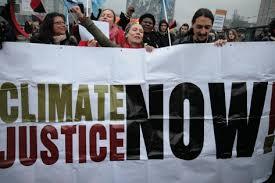Dear fellow fighters in the Climate Justice Movement:
I am a long-time advocate of both climate justice and fundamental system change. I am writing to you with whom I share these central political commitments because I believe you are making a serious strategic mistake by categorically rejecting international carbon trading.
Recently your organization, together with over sixty other environmental justice organizations, sent a letter to the President of the AFL-CIO “imploring labor to join us in the fight against climate change,” explaining what labor must do differently if it expects to advance its cause. You obviously understand why we must sometimes reach out with advice to allies in struggle who we believe are making serious mistakes. That is the spirit in which I write you this letter.
I urge your organization to join together with much larger environmental organizations which may not endorse “system change” and declare your support for the only international program with any chance of averting catastrophic climate change in an equitable way before it is too late: Serious mandatory caps on national emissions set according to differential responsibility and capability accompanied by international carbon trading. If climate justice organizations continue to categorically dismiss cap-and-trade policies and carbon markets as “false solutions,” I am afraid they will further alienate those joining our desperate fight to prevent climate change in the here and now.[1]
Denouncing cap and trade and carbon markets as “false solutions” has become ubiquitous in the climate justice movement. It was featured in the Durban Declaration in 2004, the Copenhagen Klimaforum09 Declaration in 2009, and the Cochabamba Peoples’ Agreement on Climate Change and the Rights of Mother Nature in 2010. Ill-informed denunciations of cap and trade and carbon markets are featured in numerous books and videos by prominent spokespersons for the movement.[2] Just last month Naomi Klein charged that “green groups may be more dangerous than climate change deniers” in an interview published in Salon Magazine, and Patrick Bond criticized President Correa of Ecuador and President Morales of Bolivia as “Pink Petro Keynesians” in an interview on the Real News Network.
The sad reality is that the very policies climate justice organizations condemn are the only way in the relevant timeframe to force the advanced economies to bear the burden of necessary emission reductions; they are the only way in the relevant timeframe to secure significant transfers of income from more developed countries to less developed countries; and they are the only way to protect indigenous ways of life in jungle forests. Fortunately the climate justice movement need not change any other part of its message and program in order to correct this tragic mistake and become an important part of broader efforts to avoid climate change. Nuclear power is a false solution. Geo-engineering is a false solution. Natural gas is not a bridge transition fuel. Governments are doing nothing—playing Nero’s fiddle while greenhouse gas concentrations approach levels that will make climate change unavoidable. Public outrage is what is called for. Massive demonstrations and civil disobedience are desperately needed to overcome lethargy and catalyze needed political action. And yes, economic “system change”—replacing the capitalist global market system with some form of eco-socialism—is the only way to adequately protect the environment in the long-run. The climate justice movement has got all these important things right. Unfortunately, by insisting on rejecting carbon trading in any form, the radical wing of the environmental movement is undermining its credibility and treating as enemies those who should be allies.
The Necessity of International Carbon Markets
The conclusion that international carbon markets are necessary seems to me unavoidable. It follows from several incontrovertible facts.
Fact 1: Political reality: While global capitalism must eventually be replaced by eco-socialism if we are to fully protect the environment, this is not going to happen in the next ten years because eco-socialism requires massive political support that cannot be won overnight. It is true that the forces fighting against the fossil fuel industry and its allies have suffered setbacks over the past five years. But the movement to replace capitalism with eco-socialism is weaker still. There is simply no realistic possibility that majoritarian support for global eco-socialism can be won in fewer than ten years.
Fact 2: Scientific reality: Science tells us that we cannot afford to fail to reduce global emissions dramatically over the next decade. A business-as-usual emissions scenario over the next ten years will generate massive damage and run an unacceptable risk of triggering changes that are truly cataclysmic.
Conclusion 1: Facts 1 and 2 together imply that we must reduce global emissions dramatically even while global capitalism persists. There is nothing wrong with calling for system change—which I do at every opportunity. But it is irresponsible to preach that system change alone can prevent catastrophic climate change because, regrettably, system change cannot occur soon enough. Something effective must be done now even while the global market system persists.
Fact 3: The free rider dilemma: Voluntary commitments by national governments to reduce emissions will not work. Theory predicts it and history has proved it: Under voluntary reductions the UK, for example, would pay for 100% of its own emission reductions but enjoy less than 1% of the benefits from its reductions since the UK has less than 1% of the world’s population. On the other hand, under the Kyoto Protocol, which required all developed economies to reduce emissions, while the UK still pays for 100% of its own reductions it enjoys the benefits of a global reduction that is 20 times greater than its own reduction. At the Earth Summit in Rio de Janeiro in 1992 governments of advanced economies all promised to voluntarily reduce emissions significantly. But when governments reconvened in Kyoto five years later not a single one had reduced emissions. In short, without a treaty that sets mandatory reductions on national emissions through mutual agreement we will fail to prevent climate change.
Fact 4: Environmental justice: Unless very different caps are set on national emissions for countries that bear different “responsibilities” for causing the problem and have different “capabilities” for solving the problem, poor developing nations will be treated unfairly.
Fact 5: Cost differentials: Many of the cheapest ways to reduce carbon emissions are to be found in less developed countries.
Conclusion 2: Facts 3 and 4 together imply that for an effective treaty to also be fair it must hold wealthy countries accountable for the bulk of global emissions reductions. Once this is done, fact 5 implies that international carbon trading dramatically reduces the overall global cost of preventing climate change while forcing the advanced economies to pay for those costs.
Why? Because sources in wealthy countries with low caps and high reduction costs will find it in their interest to purchase emission reduction credits from sources in poor countries with high caps and low reduction costs. In other words, carbon trading locates reductions where they are cheapest, largely in poorer countries, but ensures that wealthy countries pay for them. Unlike Larry Summers’ infamous suggestion that it is “efficient” to deposit even more toxic wastes in countries where life expectancy is low, having wealthy countries pay for carbon reductions in poor countries has the additional benefit—since reducing carbon emissions also reduces other pollutants as well—of lowering citizens’ of poor countries exposure to toxic wastes.
Why is it important to locate reductions where they are cheapest? If the global cap is low enough to be effective—that is, to reduce global emissions by at least 80% by 2050—and if different national caps are set fairly, then carbon trading can cut the overall cost of preventing climate change by as much as 50%. This is important for two reasons: It will reduce political resistance in wealthier countries to cutting emissions by enough to avoid disastrous climate change. And it will generate a large flow of payments from sources in wealthy countries to sources in poor countries. Payments for carbon credits from the global North to the global South under a fair and effective treaty would dwarf the size of any climate “reparation payments” Northern governments would ever agree to pay because carbon credits are based on self-interest rather than charity motivated by guilt.
The recent break down in efforts to secure enough money from wealthy countries to pay Ecuador to ban oil exploration in Yasuni National Park is a perfect example of why the “guilt money” strategy will not work. Ecuador was willing to forego an estimated $22 billion in oil revenues in exchange for a $3.6 billion payment, but governments of wealthy countries could not even raise half that amount.
Where Does the Climate Justice Movement Go Wrong?
Spokespersons for the climate justice movement and I share basic values. So why do I think they've gotten the carbon trading issue so wrong?
People in the climate justice movement do not like turning nature into a commodity.
And rightly so! This is one reason I have long advocated replacing capitalism with eco-socialism. But there is one thing worse than making nature into a commodity, and that is to allow the most powerful and least socially responsible actors among us to appropriate and abuse nature at will precisely because it belongs to nobody and is there for the taking. And that is exactly what happens to nature in a global market economy. In such an economy the choice is whether to allow those emitting greenhouse gases to continue to do so free of charge, or to charge them for the privilege of doing so. In a market economy failure to charge people for using nature by emitting carbon into the upper atmosphere is tantamount to allowing them to appropriate mother nature as their own private commodity to abuse as they will, free of charge. Until capitalism is replaced by eco-socialism we are far better off putting a price on using nature than allowing the price to be zero by default.
People in the climate justice movement are fearful that Wall Street will take advantage of and destroy the carbon market.
Nobody has been more outspoken in criticism of the financial industry than I have. Nobody has preached louder than I have that free market finance is an accident waiting to happen. But Wall Street greed is not a reason to refrain from creating a carbon market.
There are only two ways to prevent the financial industry from ripping off sizable chunks of economic output while creating conditions that give rise to financial crises. The best way is to replace private with public finance. The only other way to protect the rest of us from Wall Street excesses is to restructure the financial industry and subject it to regulations that are appropriate and competent.
In either case—if we replace private with public finance, or if we subject private finance to effective regulation—we need not fear that carbon allowances will become part of the next toxic financial cocktail. Moreover, if we fail to reform finance in one of these two ways, it is almost certain there will be more financial cocktail crises, whether or not carbon allowances are one of its ingredients. In other words, we cannot prevent future financial crises by refusing to create certified carbon emission reduction credits. Future financial crises can only be prevented by successful financial reform.
However, consider a worst-case scenario. Suppose Wall Street mixes carbon allowances into a terrible, toxic, financial potion, and suppose this new asset bubble does burst with a vengeance. In this case Wall Street would siphon off a big chunk of world product—first by trading in toxic assets that include carbon allowances as the bubble builds, and then by shifting the cost of the financial cleanup onto the rest of us when the bubble bursts. But this has nothing to do with the number of carbon permits in existence, and therefore nothing to do with how much carbon can be emitted. Moreover, such a financial crisis would not be the fault of the carbon market. This tragedy would be due entirely to the failure to either nationalize the financial sector or subject it to effective regulation. Denying Wall Street access to one new commodity, carbon allowances, will not prevent future crises if the financial industry remains free from effective regulation.
Critics of cap and trade worry that sellers of emission reduction credits will be awarded more credits than they deserve, which will puncture a hole in the cap on global emissions and thereby undermine the effectiveness of the treaty—turning it into a “false solution.”
Suppose a source sells credits for 100 metric tons of emissions reductions but in truth does not reduce emissions by a single ton. In other words, suppose a source is somehow certified to sell credits that are entirely “bogus.” This is the scenario many in the climate justice movement obsess over. The fact is this cannot reduce global reductions one iota provided the source selling the bogus credits is located in a country whose national emissions are capped. This fact is well known among progressive environmental economists who work on the issue of climate change. And since it is a source of great confusion in the climate justice movement I have explained why it is the case at length in articles published in the Review of Radical Political Economics and in Capitalism, Nature, Socialism.[3] But to make a long story short, the cap on national emissions forces someone else inside the country from which a bogus credit is sold to make up the difference. This is certainly unfair and objectionable. But it does not undermine the effectiveness of the treaty with regard to reaching its global reduction target.
It is perfectly possible to cap emissions in all countries in an equitable way—which should be the principle focus of climate justice organizations since the great danger is that even if we succeed in reducing global emissions sufficiently it will be done unfairly. It would mean, for example, setting a cap for a very poor country like the Republic of the Congo above its current emissions level while setting a cap for the US considerably below its current emissions. When emissions are not capped for some countries, as was the case under the Kyoto Protocol, corrupt practices can undercut global reductions. But once all countries are capped fairly, even if bogus credits are sold global reductions cannot be undermined.
A Five Point Program to Unite Us All
In the next few years when I am marching in the streets and engaging in civil disobedience I will be chanting: “Leave the Oil in the Soil! Leave the Coal in the Hole! Leave the Tar Sand in the Land! Leave the Fracking Shale Gas under the Grass!” But unlike some in the climate justice movement I will not confuse good slogans and chants with a political program to prevent climate change. A program is a set of policies that will achieve these results even while capitalism persists, such as the one outlined below. It is a program that climate justice activists who believe in system change, and climate reformers who may not, should be able to agree on.
1. Let Science Set the Global Emission Cap
Insist that scientists who study the climate—not economists—are the experts best suited to advise us about how much reduction in global net emissions is necessary. Climate scientists have proved to be the best negotiators for an aggressive response to the danger of climate change. The power of their testimony has now moved reductions of 80 percent, or more, by 2050, or sooner, smack into the middle of the bargaining table, and fixed discussion on the necessity of stabilizing atmospheric concentrations of greenhouse gases at 350 parts per million, or less.
2. Caps for All Countries
Under Kyoto, trading bogus carbon credits could only puncture holes in the global emissions cap when projects in less developed countries (so-called non-Annex-1 countries) where national emissions were not capped sold bogus emission reduction credits to governments or sources in more developed countries (Annex-1 countries) with national emission caps. The obvious solution to this problem is to cap emissions in all countries—that is, eliminate the distinction between Annex-1 and non-Annex-1 countries in the Kyoto framework altogether.
3. Equitable Caps: Greenhouse Development Rights Framework
One excellent proposal for determining equitable caps for developed and developing countries alike is the Greenhouse Development Rights Framework.[4] The authors have created a practical formula using readily available data to assign differential caps to all countries on a continuum that considers only a country’s residents who have enjoyed economic development, combining those residents’ “responsibility” and “capacity.” Climate justice advocates should be waving copies of the GDRF pamphlet—like others once waved Mao’s Little Red Book—when demonstrating in the streets at international climate conferences.
4. Cap Net Emissions
It is extremely important to eliminate perverse incentives to destroy existing forests and provide positive incentives for forest conservation. Even if we do not take other environmental benefits from forest conservation into account, destroying existing forests is very counterproductive simply from the perspective of net carbon emissions. The international treaty should cap national net emissions rather than emissions. In which case, governments would have an incentive to discourage activities that increase net emissions, like deforestation, even when followed by replanting. The international treaty need not dictate to governments how they go about this.
While not as exciting as denouncing global capitalism and calling for system change, most in the climate justice movement find nothing concrete to object to in these first four proposals. It is only the last proposal that has proved controversial: once these four improvements in the Kyoto framework are made, countries and sources should be allowed to trade certified emission reduction credits if they wish.
5. International Carbon Markets with a New Sheriff
As already explained, when national net emissions are capped equitably carbon trading (a) lowers the global costs of preventing climate change considerably, thereby reducing political opposition to an effective treaty in wealthy countries, and (b) generates a large flow of payments from the global North to the global South. Moreover, once net emissions are capped in all countries the international treaty organization has nothing at stake with regard to the legitimacy of carbon trading because planned global reductions would be secure even if bogus credits were traded. Furthermore, the governments of all countries would have a powerful incentive to prevent private parties within their borders from selling bogus credits in the international carbon market. If country governments whose net emissions are capped fail to prevent bogus sales, either those governments or their citizens would suffer the adverse consequences of having to cover the shortfall by reducing net emissions or buying more credits than they would have had to otherwise. So not only can the treaty safely permit carbon trading, it can relieve itself of the burden of certifying emission reductions for sale and leave that to national governments.
No doubt governments of poor counties will appreciate all the assistance they can get from the professional staff of an agency of the international climate treaty with expertise in establishing baselines to measure “additionality” and detect “leakage” when certifying credits for sale. But it is national governments that should be put in charge of final approval for projects within their own borders seeking to sell credits in international carbon markets. Any government which simply chose not to certify emission reduction credits for sale, would of course be free to do so.
All too many critiques of carbon trading stem in part from confusion about what is easy and what is difficult to measure. It is relatively easy to measure national annual net emissions and count up certified emission reduction credits bought and sold by sources within countries. And this is all that is necessary for the treaty organization to determine if signatories have met, or failed to meet, their treaty obligations. It is far more difficult to measure how much any project reduces net emissions compared to what would have happened otherwise. This means it is sometimes difficult to know how many credits to certify for sale in the international carbon market. The above proposal guarantees that mistakes in certification do not undermine the effectiveness of the treaty, and shifts the difficult task of certification from the treaty organization to national governments since mistakes merely create inequities among their own citizens.
I urge the climate justice movement to rethink its dismissal of cap and trade and carbon markets. These policies are, of course, not ultimate solutions. But they offer us a margin of hope to forestall cataclysmic climate change.
In Solidarity,
Robin Hahnel
Professor Emeritus, Department of Economics
American University, Washington DC
[email protected]
















